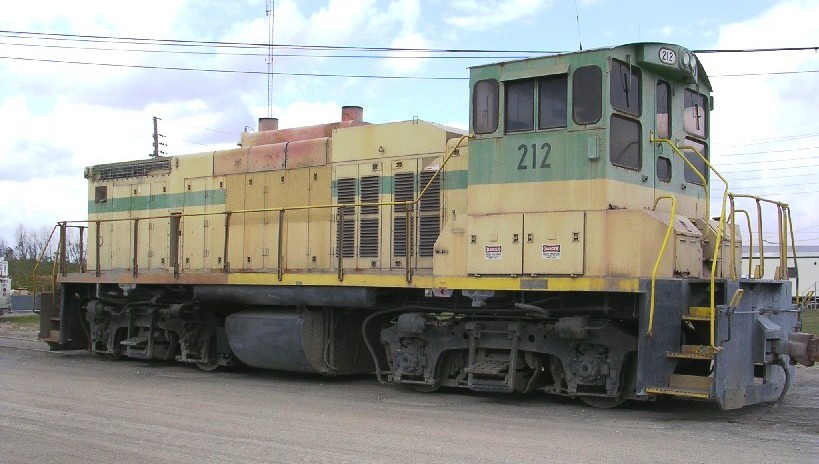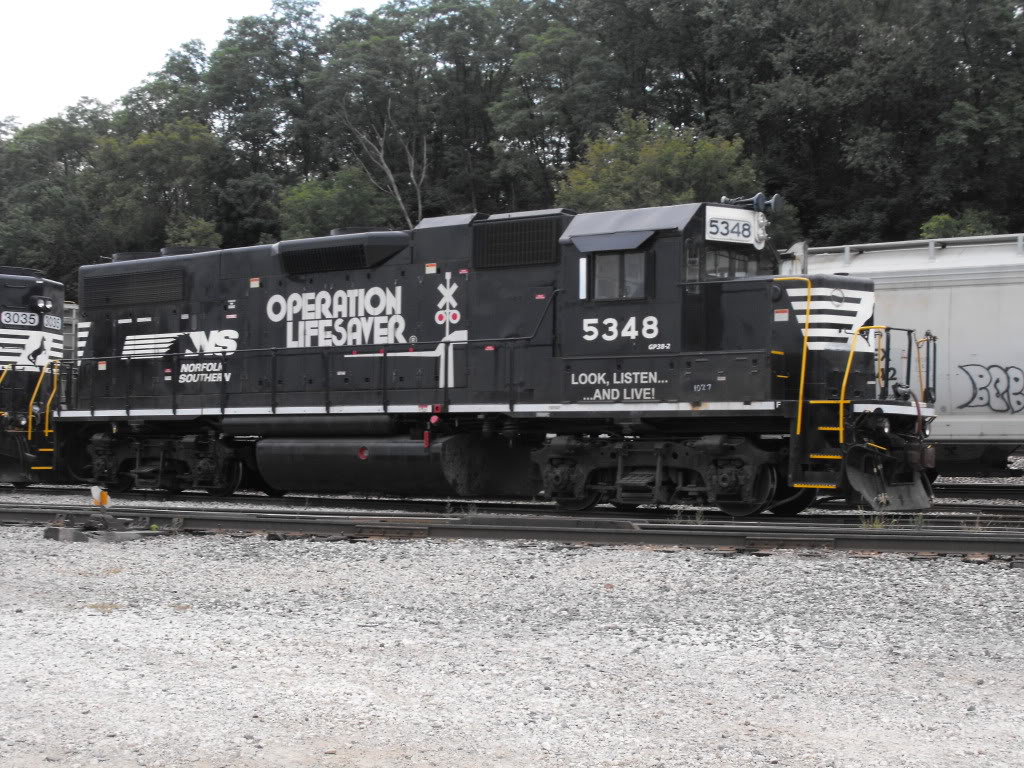|
Sri Lanka Railways M7
Class M7 is a type of diesel-electric locomotive built for Sri Lanka Railways by Brush Traction, UK, and imported in 1981. This locomotive has the shortest length, least power and least weight compared to other diesel locomotives of Sri Lanka. History Three locomotives (803, 813, 814) were painted in a special color scheme and later was painted in normal livery. In 1999 M7 locomotive No. 803 met with an accident and was seriously damaged. 803 is a non runner, Usage This locomotive was introduced as a shunter by the manufacturer, Brush Traction. In Sri Lanka, these are mostly used in short passenger services. M7s are not permitted on the Main Line because of the low power and lack of dynamic braking but it can be run on all the other of the railway lines in Sri Lanka including the Kelani Valley Line. Gallery File:SRI LANKAN RAILWAYS CLASS M7 LOCO HAULED TRAIN AT GALLE STATION SRI LANKA JAN 2013 (8553523801).jpg, A M7 at Galle Galle ( si, ගාල්ල, translit=Gālla; ... [...More Info...] [...Related Items...] OR: [Wikipedia] [Google] [Baidu] |
Brush Traction
Brush Traction is a manufacturer and maintainer of railway locomotives in Loughborough, England. It is a subsidiary of Wabtec. History Hughes's Locomotive & Tramway Engine Works Henry Hughes had been operating at the Falcon Works since the 1850s, producing items such as brass and iron cast parts for portable engines and thrashing machines. In 1860 Henry Hughes announced he had entered into a partnership with William March who had extensive experience in the timber trade, and this would be added to the existing business of "engineers and manufacturers of railway plant", with the business to be called Hughes and March. In March 1863, Hughes announced it was making a steam locomotive designed for contractors and mineral railways. This was an 0-4-0 saddle tank with a 200 psi boiler pressure and cylinders of 10 inch bore and 15 inch stroke. In 1866, Hughes announced a sale of timber and associated equipment from the "Falcon Railway Plant Works" as he had decided to close down ... [...More Info...] [...Related Items...] OR: [Wikipedia] [Google] [Baidu] |
General Motors
The General Motors Company (GM) is an American Multinational corporation, multinational Automotive industry, automotive manufacturing company headquartered in Detroit, Michigan, United States. It is the largest automaker in the United States and was the largest in the world for 77 years before losing the top spot to Toyota in 2008. General Motors operates manufacturing plants in eight countries. Its four core automobile brands are Chevrolet, Buick, GMC (automobile), GMC, and Cadillac. It also holds interests in Chinese brands Wuling Motors and Baojun as well as DMAX (engines), DMAX via joint ventures. Additionally, GM also owns the BrightDrop delivery vehicle manufacturer, GM Defense, a namesake Defense vehicles division which produces military vehicles for the United States government and military; the vehicle safety, security, and information services provider OnStar; the auto parts company ACDelco, a GM Financial, namesake financial lending service; and majority ownership in t ... [...More Info...] [...Related Items...] OR: [Wikipedia] [Google] [Baidu] |
V8 Engine
A V8 engine is an eight-cylinder piston engine in which two banks of four cylinders share a common crankshaft and are arranged in a V configuration. The first V8 engine was produced by the French Antoinette company in 1904, developed and used in cars and speedboats but primarily aircraft; while the American 1914–1935 ''Cadillac L-Head'' engine is considered the first road going V8 engine to be mass produced in significant quantities. The popularity of V8 engines in cars was greatly increased following the 1932 introduction of the ''Ford Flathead V8''. In the early 21st century, use of V8 engines in passenger vehicles declined as automobile manufacturers opted for more fuel efficient, lower capacity engines, or hybrid and electric drivetrains. Design V-angle The majority of V8 engines use a V-angle (the angle between the two banks of cylinders) of 90 degrees. This angle results in good engine balance, which results in low vibrations; however, the downside is a larg ... [...More Info...] [...Related Items...] OR: [Wikipedia] [Google] [Baidu] |
2-stroke Engine
A two-stroke (or two-stroke cycle) engine is a type of internal combustion engine that completes a power cycle with two strokes (up and down movements) of the piston during one power cycle, this power cycle being completed in one revolution of the crankshaft. A four-stroke engine requires four strokes of the piston to complete a power cycle during two crankshaft revolutions. In a two-stroke engine, the end of the combustion stroke and the beginning of the compression stroke happen simultaneously, with the intake and exhaust (or scavenging) functions occurring at the same time. Two-stroke engines often have a high power-to-weight ratio, power being available in a narrow range of rotational speeds called the power band. Two-stroke engines have fewer moving parts than four-stroke engines. History The first commercial two-stroke engine involving cylinder compression is attributed to Scottish engineer Dugald Clerk, who patented his design in 1881. However, unlike most later two-st ... [...More Info...] [...Related Items...] OR: [Wikipedia] [Google] [Baidu] |
Diesel Engine
The diesel engine, named after Rudolf Diesel, is an internal combustion engine in which ignition of the fuel is caused by the elevated temperature of the air in the cylinder due to mechanical compression; thus, the diesel engine is a so-called compression-ignition engine (CI engine). This contrasts with engines using spark plug-ignition of the air-fuel mixture, such as a petrol engine (gasoline engine) or a gas engine (using a gaseous fuel like natural gas or liquefied petroleum gas). Diesel engines work by compressing only air, or air plus residual combustion gases from the exhaust (known as exhaust gas recirculation (EGR)). Air is inducted into the chamber during the intake stroke, and compressed during the compression stroke. This increases the air temperature inside the cylinder to such a high degree that atomised diesel fuel injected into the combustion chamber ignites. With the fuel being injected into the air just before combustion, the dispersion of the fuel is une ... [...More Info...] [...Related Items...] OR: [Wikipedia] [Google] [Baidu] |
Sri Lanka Railways
The Sri Lanka Railway Department (more commonly known as Sri Lanka Railways (SLR)) ( Sinhala: ශ්රී ලංකා දුම්රිය සේවය ''Śrī Laṃkā Dumriya Sēvaya''; Tamil: இலங்கை புகையிரத சேவை ''Ilankai Pugaiyiradha Sēvai'') is Sri Lanka's railway owner and primary operator. As part of the Sri Lankan government, it is overseen by the Ministry of Transport. Founded in 1858 as the Ceylon Government Railway, it operates the nation's railways and links Colombo (the capital) with other population centres and tourist destinations. The Sri Lankan rail network is of broad gauge. Some of its routes are scenic, with the main line passing (or crossing) waterfalls, mountains, tea estates, pine forests, bridges and peak stations. History Beginnings The construction of a railway in Ceylon was first raised in 1842 by European coffee planters seeking a line be constructed between Kandy and Colombo as a quicker more effic ... [...More Info...] [...Related Items...] OR: [Wikipedia] [Google] [Baidu] |
Diesel Locomotives Of Sri Lanka
Locomotives and train sets of Sri Lanka Railways consist mostly of diesel locomotives and multiple units. Steam locomotives are no longer used, except on heritage trains, such as the Viceroy Special. The first locomotives pulled trains on the original segment of the Main Line, on connecting Colombo and Ambepussa. In 1953, Sri Lanka Railways enhanced its service to more power with diesel locomotives. Since then, various types of diesel locomotives were added to the service. History Sri Lanka's first railway locomotive was ''Leopold'', in 1864. It was one of seven 4-4-0 locomotives built that year for the Ceylon Government Railway by Robert Stephenson & Company (nos. 1–5) and Beyer, Peacock & Company (nos. 6 and 7). Many more steam locomotives were added to the system, through to the 1950s. All the steam locomotives bar three were manufactured in the United Kingdom; the exceptions were three 4-4-0s built at the railway's Maradana Works near Colombo in 1900 and 1905. In 19 ... [...More Info...] [...Related Items...] OR: [Wikipedia] [Google] [Baidu] |
Shunter
A switcher, shunter, yard pilot, switch engine, yard goat, or shifter is a small Rail transport, railroad locomotive used for manoeuvring railroad cars inside a rail yard in a process known as Shunt (railway operations), ''switching'' (US) or ''shunting'' (UK). Switchers are not intended for moving trains over long distances but rather for assembling trains in order for another locomotive to take over. They do this in classification yards (Great Britain: ''marshalling yards''). Switchers may also make short transfer runs and even be the only motive power on branch lines and switching and terminal railroads. The term can also be used to describe the workers operating these engines or engaged in directing shunting operations. Switching locomotives may be purpose-built engines, but may also be downgraded main-line engines, or simply main-line engines assigned to switching. Switchers can also be used on short excursion train rides. The typical switcher is optimised for its job, be ... [...More Info...] [...Related Items...] OR: [Wikipedia] [Google] [Baidu] |
Main Line (Sri Lanka)
The Main Line is a major railway line in the rail network of Sri Lanka and considered by many to be one of the most scenic train journeys in all of Asia. The line begins at Colombo Fort and winds through the Sri Lankan hill country to reach Badulla. Route definition The Main Line starts from Colombo and runs east and north past the rapidly developing centres of Ragama, Gampaha, Veyangoda, and Polgahawela. At Rambukkana, the Main Line begins its steep climb into the hills of the upcountry. Between Balana and Kadugannawa, the track clings to the side of sheer cliffs, offering passengers views of Batalegala ('Bible' Rock). From Peradeniya Junction, a branch line reaches Kandy and Matale. The Main Line then continues its climb through tea country, connecting local market centres at Gampola, Nawalapitiya, and Hatton before reaching Nanu Oya. This is the connection to the former colonial resort of Nuwara Eliya, known for its temperate climate, classic hotels, and British-st ... [...More Info...] [...Related Items...] OR: [Wikipedia] [Google] [Baidu] |
Dynamic Braking
Dynamic braking is the use of an electric traction motor as a generator when slowing a vehicle such as an electric or diesel-electric locomotive. It is termed " rheostatic" if the generated electrical power is dissipated as heat in brake grid resistors, and " regenerative" if the power is returned to the supply line. Dynamic braking reduces wear on friction-based braking components, and regeneration lowers net energy consumption. Dynamic braking may also be used on railcars with multiple units, light rail vehicles, electric trams, trolleybuses, and electric and hybrid electric automobiles. Principle of operation Converting electrical energy to the mechanical energy of a rotating shaft (electric motor) is the inverse of converting the mechanical energy of a rotating shaft to electrical energy (electric generator). Both are accomplished through the interactions of armature windings with a (relatively) moving external magnetic field, with the armature connected to an electrical ... [...More Info...] [...Related Items...] OR: [Wikipedia] [Google] [Baidu] |
Kelani Valley Line
The Kelani Valley railway line in Sri Lanka, covering the breadth of Colombo District. The line is owned, maintained, and operated by Sri Lanka Railways. Route definition and overview The Kelani Valley line runs southeast from Colombo Maradana Station, through much of the city of Colombo. It runs through major business centres, like Nugegoda and Maharagama, before turning eastwards. It crosses the Southern Expressway near Homagama and continues east towards Avissawella, the current terminus of the line. The line serves an increasingly urbanising community. Major railway stations on the line are Colombo Fort, Maradana, Narahenpita, Nugegoda, Maharagama, Pannipitiya, Kottawa, Homagama, Meegoda, Padukka, Waga, Kosgama, and Avissawella. History Narrow-gauge era The Kelani Valley line was originally built from Colombo to Yatiyanthota via Avissawella during 1900–1902. It was branched off at Avissawella and extended up to Opanayaka via Ratnapura (completed in 1912). Or ... [...More Info...] [...Related Items...] OR: [Wikipedia] [Google] [Baidu] |







